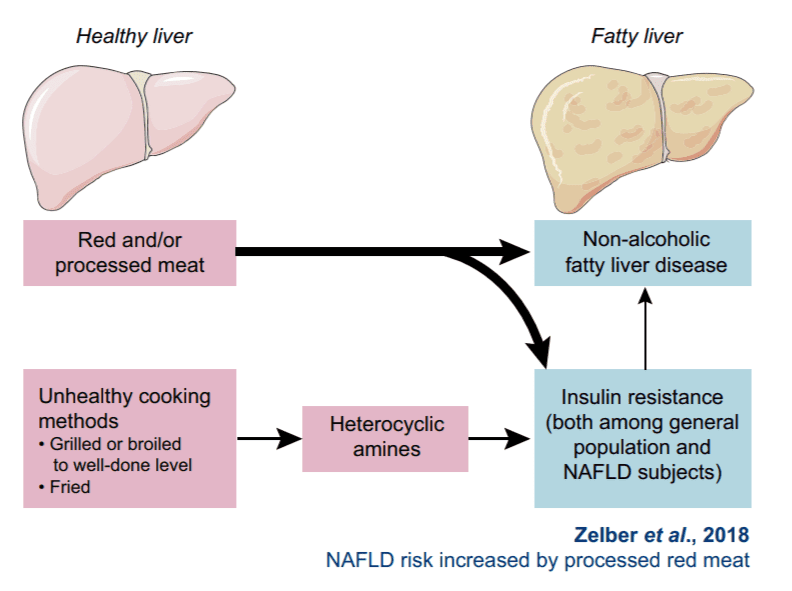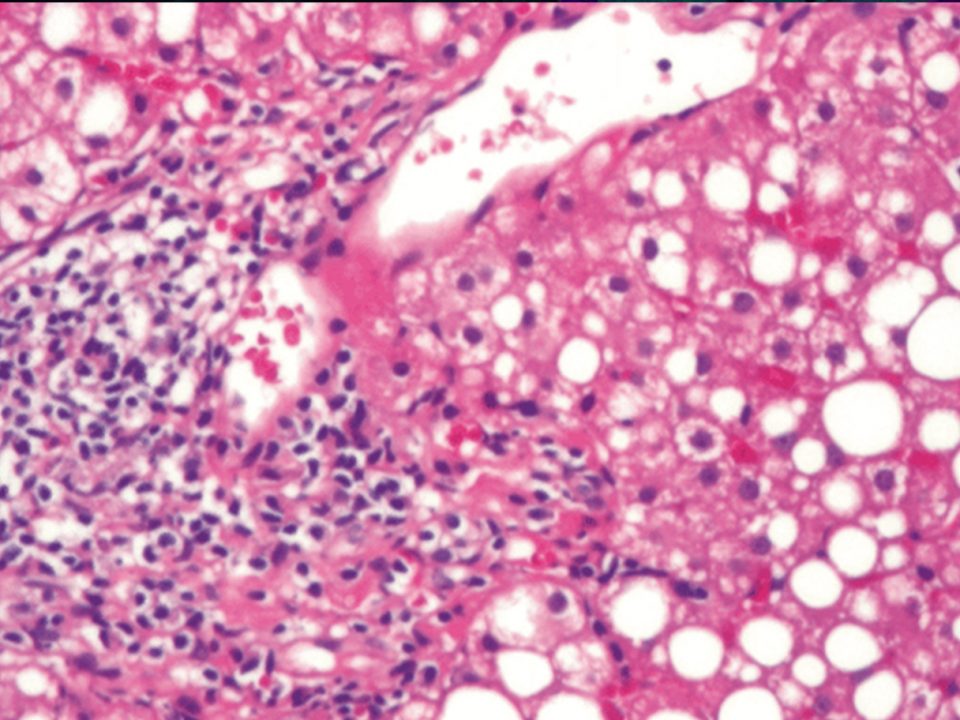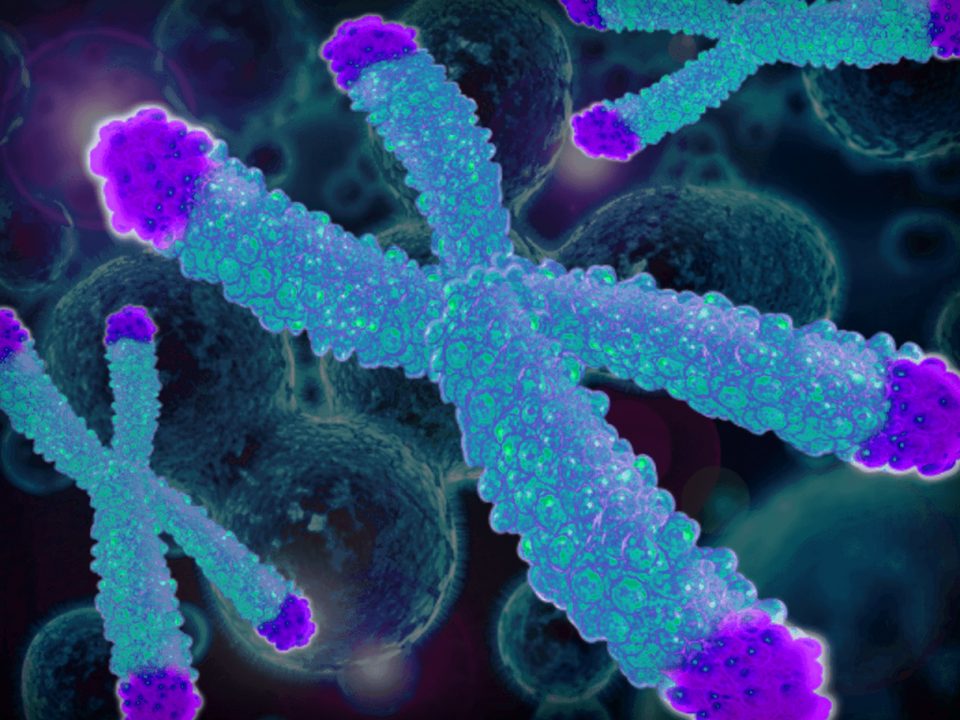Non-alcoholic fatty liver disease & other

Liver Regeneration
21.09.2019
Telomeres, NAFLD and Chronic Liver Disease
21.09.2019
Authors: Richard Moreau , Ramon Bataller, Thomas Berg, Jessica Zucman-Rossi, Rajiv Jalan.
NAFLD risk increased by processed red meat
High red and processed meat consumption, particularly increased intake of heterocyclic amines (HCAs) which are linked to oxidative stress, has been associated with type-2 diabetes. In this issue, Zelber et al. studied the association of meat consumption with non-alcoholic fatty liver disease (NAFLD) in a large cohort of patients. High consumption of total meat, red and/or processed meat were independently associated with higher odds of NAFLD and insulin resistance (IR), respectively, after adjusting for factors including BMI and physical activity. High intake of meat cooked using unhealthy methods and HCAs were independently associated with higher odds of IR. This important epidemiological study suggests that high consumption of red and/or processed meat is associated with both NAFLD and insulin resistance. If confirmed in prospective studies, limiting the consumption of unhealthy meat types and improving preparation methods may be considered as part of NAFLD prevention policies.
NON-ALCOHOLIC FATTY LIVER DISEASE
Beneficial effects of prolactin
In another study in this issue, Zhang et al. study the potential role of prolactin, a multifunctional polypeptide with effects on metabolism, on hepatic steatosis and lipid metabolism. The authors found that circulating prolactin was lower in individuals with ultrasound diagnosed NAFLD than in healthy controls. Moreover, prolactin levels in patients with severe hepatic steatosis were lower than in those with mild-tomoderate hepatic steatosis in both men and women. Furthermore, human hepatic prolactin receptor gene expression was reduced in patients with NAFLD and negatively correlated with CD36. In free fatty acid-induced cultured hepatocytes, prolactin treatment or receptor overexpression significantly reduced the expression of CD36 and lipid content, which was abrogated after gene silencing. Furthermore, overexpression of CD36 reduced prolactin-mediated improvement in lipid content. This interesting translational study suggests a novel association between prolactin and lipid accumulation via the CD36 pathway. Further studies should explore if manoeuvres increasing prolactin levels have beneficial effects in NAFLD.
HEPATITIS B VIRUS (HBV) INFECTION
Opening the door to early treatment, oral antiviral treatment normalises patients’ survival, the big bang of hepatitis B viral evolution
The long-term sequelae of vertical HBV transmission, which in most children leads to a highly replicative chronic infection, is not well defined. Treatment is generally not recommended for these children, as the course of this infection – formerly called immune-tolerant – is considered benign and the serologic response rates are low. In this issue of the Journal Zhu et al. report on their study evaluating for the first time an early interferon-based antiviral treatment approach in HBVinfected children with immune-tolerant characteristics in a randomised controlled fashion. In the treatment group 33% of children achieved hepatitis B e antigen (HbeAg) seroconversion and 22% loss of hepatitis B surface antigen (HBsAg), whereas none developed HBsAg clearance in the control group, and the rate of HBeAg seroconversion was only 4%. This important pilot study will probably not change the current management of HBVinfected children with immune-tolerant characteristics, and larger studies with longer follow-up after stopping therapy are needed to judge the full impact of this approach. However, the findings may open the door to a more liberal early intervention strategy aimed at treating the infection instead of waiting for the disease.
Previous studies suggest that oral antiviral treatment improves long-term outcomes in HBV-infected patients, compared to patients who remain untreated. Whether life expectancy becomes comparable to that of the general population has not been studied yet. The study by Papatheodoridis et al. is the first evaluating the long-term survival in Caucasian patients with chronic hepatitis B under oral antiviral therapy and comparing that with the survival of the general population. Regardless of the fibrosis stage at baseline, the overall and liver-related eight-year survival was excellent (94%) under HBV treatment, and similar to that of the general population. However, the finding that hepatocellular carcinoma (HCC) was the main factor affecting the overall mortality, and the only factor affecting liver-related mortality clearly illustrates the need for long-term careful HCC surveillance, but also for early treatment initiation, as advanced fibrosis stages remain the main risk factor for hepatocarcinogenesis.

Unlike other major blood-borne viruses, such as the human immunodeficiency viruses, there is no evidence for an evolutionary origin of human HBV from viruses carried by Old World non-human primates, and similarly, the evolutionary origins of the divergent human HBV genotypes F and H associated with American natives inhabiting Alaska and Latin America are unknown. De Carvalho Dominguez Souza et al. screened New World non-human primates and discovered a novel HBV species in capuchin monkeys termed CMHBV. By evolutionary and functional analyses they proposed new hypotheses for primate HBV evolution which suggest ancestral co-speciation of hepadnaviruses and non-human primates, and an Old World origin of the divergent HBV genotypes F and H. These findings together with important similarities between the infection patterns of the novel hepadnavirus and HBV will inspire new perspectives to investigate HBV pathogenesis and cure.
Unlike other major blood-borne viruses, such as the human immunodeficiency viruses, there is no evidence for an evolutionary origin of human HBV from viruses carried by Old World non-human primates, and similarly, the evolutionary origins of the divergent human HBV genotypes F and H associated with American natives inhabiting Alaska and Latin America are unknown. De Carvalho Dominguez Souza et al. screened New World non-human primates and discovered a novel HBV species in capuchin monkeys termed CMHBV. By evolutionary and functional analyses they proposed new hypotheses for primate HBV evolution which suggest ancestral co-speciation of hepadnaviruses and non-human primates, and an Old World origin of the divergent HBV genotypes F and H. These findings together with important similarities between the infection patterns of the novel hepadnavirus and HBV will inspire new perspectives to investigate HBV pathogenesis and cure.
HEPATOCELLULAR CARCINOMA AND TRANSPLANTATION
Feasibility of ABO-incompatible transplant, MRI for selection of patients with HCC for transplantation
Expanding the donor pool could reduce the death rates in patients on the liver transplant waiting lists. ABO incompatibility has traditionally been a contraindication for living donor transplantation. Yoon et al. describe the results of an important study comparing the outcome of patients with HCC undergoing living donor liver transplantation with ABOcompatible and ABO-incompatible organs. Their data provide evidence that outcomes of transplantation are not significantly different between the groups. However, they stress the importance of careful patient selection and postoperative management to achieve good results. With further independent validation, the results of this study could change clinical practice.
At present, selection of patients with HCC for transplantation relies solely on estimating the size of the tumours using either MRI or CT scanning. There is a wide variation in the risk of recurrence of HCC following transplantation. Kim et al. describe the results of a provocative retrospective study using Gadoxetic-acid enhanced MRI and identify that the presence of satellite nodules or peritumoural hypointensity identifies a group of patients with rates of recurrence of up to six times higher in patients transplanted for tumours within the Milan criteria. With independent validation, these data could result in a change in the pre-operative work up of patients with HCC for liver transplantation.
HEPATIC ENCEPHALOPATHY
Cerebral circulation in liver failure and the role of adenosine
The mechanisms underlying the pathogenesis of hepatic encephalopathy in patients with liver failure are unclear, but the role of ammonia is thought to play a central role. Cerebral vasodilation and loss of blood flow autoregulation in acute liver failure patients is associated with intracranial hypertension. Bjerring et al. describe the results of an important study, where they clearly show that the cerebral vasodilation is indeed induced by application of ammonia, which was associated with profound adenosine release in the peri-arteriolar area. Application of an adenosine receptor antagonist prevented the ammoniainduced cerebral vasodilation and normalised the cerebral autoregulatory index. The study provides a potentially novel strategy for the treatment of this deadly complication of acute liver failure.
HEPATOCELLULAR CARCINOMA AND CHOLANGIOCARCINOMA (CCA)-BASIC
O-GlcNAcylation of RACK1 promotes HCC, a circular RNA that decreases HCC progression, MCL1 prevents CCA cell necrosis
Aberrant oncogenic mRNA translation and protein O-linked b-N-acetylglucosaminylation (O-GlcNAcylation) are general features during tumourigenesis. Ribosomal RACK1 is known to promote the chemoresistance and growth in HCC. OLinked b-N-acetylglucosamine (O-GlcNAc) functions in the O-b-glycosidic attachment of a single N-acetylglucosamine (GlcNAc) to the serine and threonine residues of nuclear or cytoplasmic proteins. Duan et al. hypothesised that RACK1 O-GlcNAcylation could play a role in oncogene translation and HCC carcinogenesis. Here, they show that RACK1 acts as key mediator linking O-GlcNAc metabolism to cap-dependent translation during HCC tumorigenesis. Targeting RACK1 O-GlcNAcylation provides promising means for HCC treatment.
Circular RNAs play critical regulatory roles in cancer biology. Because contributions of circular RNAs to HCC are poorly known, Yu et al. addressed this question using elegant approaches. They show that cSMARCA5 (a circular RNA derived from exons 15 and 16 of the SMARCA5 gene [SWI/SNF related, matrix associated, actin dependent regulator of chromatin, subfamily a, member 5]) was downregulated in the most aggressive HCCs. They suggest that cSMARCA5 downregulation results in decreased expression of the tumour suppressor TIMP3. These findings suggest that stimulating cSMARCA5 expression could be a novel therapeutic approach for HCC.
Induced myeloid leukemia cell differentiation protein Mcl-1 (also known as Bcl2-L-3; encoded by MCL1) is a prosurvival protein of the BLC2 family and plays a pivotal role in CCA cell survival. Fibroblast growth factor receptor (FGFR) signalling mediates Bcl2-L-3-dependent survival of CCA cells in vitro and in vivo, through elusive mechanisms. However, the mode and mechanisms of cell death in this model were not delineated. Kabashima et al. now show that FGFR inhibition induces loss of matrix Bcl2-L-3 resulting in cell necrosis. These findings support an unexpected alternative Bcl2-L-3 survival function, namely prevention of cell necrosis, and have implications for treatment of human CCA.

LIVER METASTASES
Liver adverse events induced by immune checkpoint blockade
Although T-cell receptors are capable of recognising and eliminating tumours, cancers evolve resistance mechanisms by using checkpoint blockade molecules to disrupt the processes of immune recognition and attack. These checkpoint blockade molecules include cytotoxic T lymphocyte-associated antigen 4 (CTLA-4) and programmed cell death 1 (PD-1), among others. Immune checkpoint blocking antibodies, such as anti-CTLA-4, antiPD-1, or anti-PD-1 ligand (PD-L1) are used to treat metastatic cancer but can result in hepatic immune-related adverse events (IRAEs). De Martin et al. report here their experience with IRAEs associated with anti-CTLA-4 or anti-PD-1/PD-L1 therapies. They reveal that acute hepatitis due to immunotherapy for metastatic cancer is seen in only 3.5% of patients, and in most cases is not severe. Moreover, histological assessment can distinguish between anti-PD-1/PD-L1 and anti-CTLA4 toxicity.



